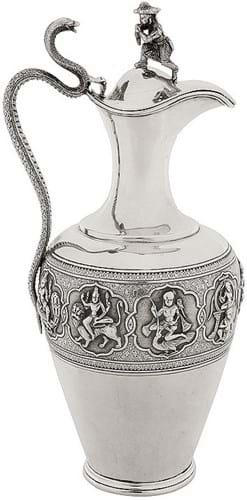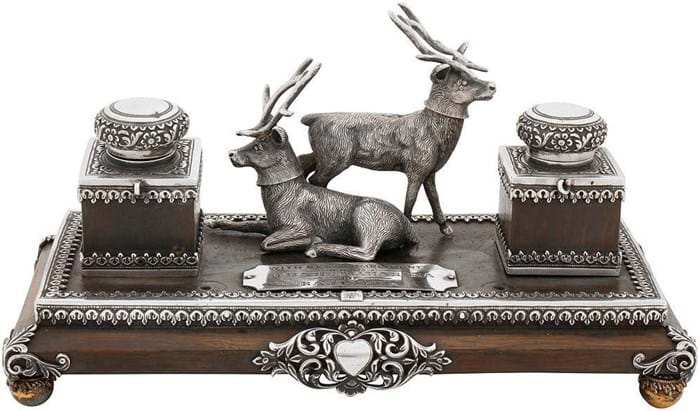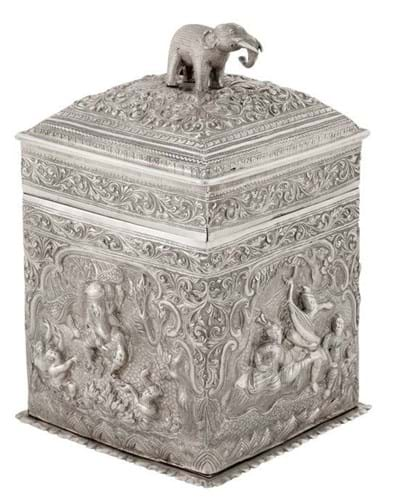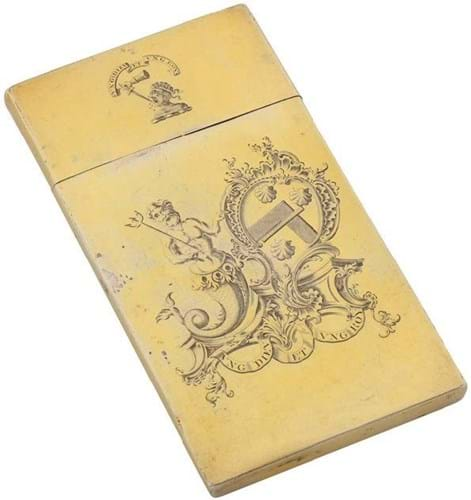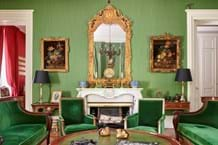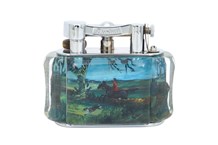
Silver sales at Chiswick Auctions (25% buyer’s premium) are known for including a curated offering of non-European silverware.
A rare addition to the auction of Silver and Objects of Vertu in west London on March 19 was a set of four unmarked gold mounted silver boxes made in the Lower Perak region of Malaysia, c.1900.
They were used to hold a beeswax and coconut oil salve that would keep the lips moist while chewing betel leaves.
Their sale at £1900 (estimate £600-800) comes ahead of a soon-to-be-published book on the topic, Michael Backman’s Malay Silver and Gold - Courtly Splendour from Indonesia, Malaysia, Singapore, Brunei and Thailand. The boxes were contested by two collectors.
All the Raj
Raj period Indian silver continues to attract great interest in the year that follows the extraordinary prices realised in the Stewart Collection (offered by Chiswick Auctions in February 2023). It is the pieces by eminent firms or those made to uncommon forms that command most attention.
An example of the well-known Swami pattern ewer made by Peter Orr and Sons of Madras, c.1880, achieved £4400. This neoclassical form, worked with a central band of nine Indian gods, was made by a number of silversmiths working in the subcontinent.
A Bangalore version of this jug marked for A Bhicajee and Co of Bombay was sold as part of the Stewart collection for £4000.
A Cutch silver inkstand by the Bhuj maker Mawji Raghavji, a rival to the famed Oomersi Mawji, exceeded the pre-sale guide of £800- 1200 to achieve £4000 hammer.
Set with two well-observed models of stags, it was engraved with a presentation inscription reading with best compliments from H.H. the Maharana of Rajpipla.
Maharana Shri Gambhirsinhji Varisalji (1847-97) began his reign in 1860 as the 34th Gohil ruler of Rajpipla, a town in the Narmada district in the Indian state of Gujarat.
Quick return
Several vendors took advantage of Chiswick specialist John Rogers’ expertise in non-European silver to consign items recently purchased in other sales.
Previously sold last October at Bukowski’s in Sweden for €650, a late 19th century silver bowl on stand reappeared here identified as pieces from the silversmithing centres of Poona and Rangoon. They sold at £2200.
Similarly, a rare and unusual Burmese cigar box and cover with an elephant finial, probably made in Mandalay c.1890, bought by the vendor for £1600 at Dore & Rees in Somerset last June, was reoffered in west London where it made £2800.
The identification of the heraldry engraved to a George II silver gilt paper or map case helped its commercial prospects.
This unusual piece of Georgian small silver, probably made in London, c.1750, was returning to the market for the third time in 15 years.
This time the arms were identified as those of Thomas Smith (c.1707-63), the illegitimate son of Sir Thomas Lyttelton, 4th Baronet (1686-1751). He had a prominent career in the Royal Navy: one time Commodore- Governor of Newfoundland, he eventually rose to the rank of Admiral of the Blue.
It sold for £800, more than twice the sum it had made at Woolley & Wallis of Salisbury in 2023, although it is indicative of a generally soft market for English silver that it had sold for $3200 in New York in 2009.
Duleep Singh link
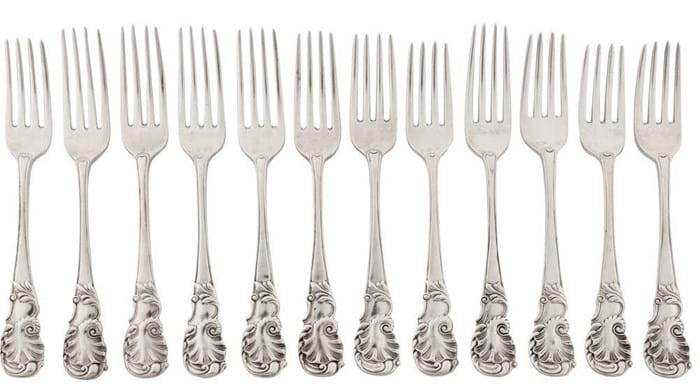
Set of 12 Rococo pattern table forks engraved with the coat of arms of Duleep Singh, £1700 at Chiswick Auctions.
The engraved coat of arms of Duleep Singh (1838-93) was the reason a set of 12 silver Rococo pattern table forks brought £1700 (estimate £1500-2500). The last ruler of the Sikh empire used a coat of arms drawn up by Prince Albert for his life in gilded cage exile. The motto Prodesse quam conspicii means ‘to do good rather than be conspicuous’.
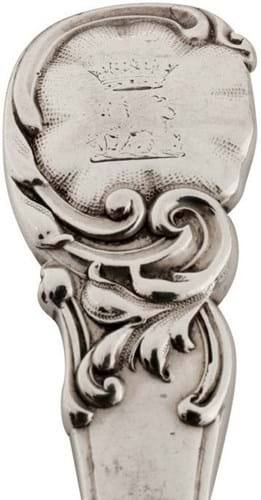
Set of 12 Rococo pattern table forks engraved with the coat of arms of Duleep Singh, £1700 at Chiswick Auctions.
It is the third example of Duleep Singh’s table silver sold at Chiswick: last year a set of six dessert spoons from this service (also for the dates 1854 and 1874) were sold for £1500 when a pair of dinner plates of 1807 bearing this crest took £4000.
The most striking piece of Victorian silver in the sale was an 18oz Aesthetic movement ewer marked for London 1881 and the maker William Hunter.
The form of this piece - that follows an ancient Mycenaean vessel - is better known in ceramic. It was among the Christopher Dresser designs used at both the Linthorpe Pottery Works (before closure in 1889) and then at the Ault Pottery.
This silver vessel, engraved with the initials ECS hammered at £2200.
Two became one

Scottish provincial gold posy ring, £1900 at Chiswick Auctions.
Discovered in a bag of modern gold jewellery, most of it of little more than bullion value, a Scottish provincial gold posy ring sold at £1900 at Chiswick.
Based on the gold price on the day, its intrinsic value was around £110.
Engraved to the interior with the motto or ‘posy’ reading God alone made us two one, the ring is also struck with the maker’s mark CJ for the Inverness goldsmith Charles Jamieson (active 1797-1819).
John Rogers immediately recognised its potential.
“Goldsmiths from before the early 19th century rarely used the letter J (instead I sufficed) so with the unusual combination of initials there was no doubt that this was for the Inverness maker Charles Jamieson,” he said.
A reasonable corpus of silver survives from this maker, mostly flatware, but also wine labels, Luckenbooth brooches, toast racks, and quaiches, but a gold ring is a remarkable rarity.


